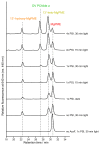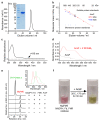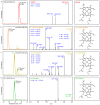How the O2-dependent Mg-protoporphyrin monomethyl ester cyclase forms the fifth ring of chlorophylls
- PMID: 33731920
- PMCID: PMC7610348
- DOI: 10.1038/s41477-021-00876-3
How the O2-dependent Mg-protoporphyrin monomethyl ester cyclase forms the fifth ring of chlorophylls
Abstract
Mg-protoporphyrin IX monomethyl ester (MgPME) cyclase catalyses the formation of the isocyclic ring, producing protochlorophyllide a and contributing substantially to the absorption properties of chlorophylls and bacteriochlorophylls. The O2-dependent cyclase is found in both oxygenic phototrophs and some purple bacteria. We overproduced the simplest form of the cyclase, AcsF, from Rubrivivax gelatinosus, in Escherichia coli. In biochemical assays the di-iron cluster within AcsF is reduced by ferredoxin furnished by NADPH and ferredoxin:NADP+ reductase, or by direct coupling to Photosystem I photochemistry, linking cyclase to the photosynthetic electron transport chain. Kinetic analyses yielded a turnover number of 0.9 min-1, a Michaelis-Menten constant of 7.0 µM for MgPME and a dissociation constant for MgPME of 0.16 µM. Mass spectrometry identified 131-hydroxy-MgPME and 131-keto-MgPME as cyclase reaction intermediates, revealing the steps that form the isocyclic ring and completing the work originated by Sam Granick in 1950.
Conflict of interest statement
The authors declare no competing interests.
Figures









Similar articles
-
Three classes of oxygen-dependent cyclase involved in chlorophyll and bacteriochlorophyll biosynthesis.Proc Natl Acad Sci U S A. 2017 Jun 13;114(24):6280-6285. doi: 10.1073/pnas.1701687114. Epub 2017 May 30. Proc Natl Acad Sci U S A. 2017. PMID: 28559347 Free PMC article.
-
Aerobic and anaerobic Mg-protoporphyrin monomethyl ester cyclases in purple bacteria: a strategy adopted to bypass the repressive oxygen control system.J Biol Chem. 2004 Feb 20;279(8):6385-94. doi: 10.1074/jbc.M309851200. Epub 2003 Nov 14. J Biol Chem. 2004. PMID: 14617630
-
Conserved residues in Ycf54 are required for protochlorophyllide formation in Synechocystis sp. PCC 6803.Biochem J. 2017 Feb 20;474(5):667-681. doi: 10.1042/BCJ20161002. Biochem J. 2017. PMID: 28008132 Free PMC article.
-
Biosynthesis of chlorophylls from protoporphyrin IX.Nat Prod Rep. 2003 Jun;20(3):327-41. doi: 10.1039/b110549n. Nat Prod Rep. 2003. PMID: 12828371 Review.
-
Chlorophyll modifications and their spectral extension in oxygenic photosynthesis.Annu Rev Biochem. 2014;83:317-40. doi: 10.1146/annurev-biochem-072711-162943. Epub 2014 Mar 12. Annu Rev Biochem. 2014. PMID: 24635479 Review.
Cited by
-
LTD coordinates chlorophyll biosynthesis and LIGHT-HARVESTING CHLOROPHYLL A/B-BINDING PROTEIN transport.Plant Cell. 2025 Apr 2;37(4):koaf068. doi: 10.1093/plcell/koaf068. Plant Cell. 2025. PMID: 40138376
-
Engineering Chlorophyll, Bacteriochlorophyll, and Carotenoid Biosynthetic Pathways in Escherichia coli.ACS Synth Biol. 2023 Aug 18;12(8):2236-2244. doi: 10.1021/acssynbio.3c00237. Epub 2023 Aug 2. ACS Synth Biol. 2023. PMID: 37531642 Free PMC article.
-
Absolute quantification of cellular levels of photosynthesis-related proteins in Synechocystis sp. PCC 6803.Photosynth Res. 2023 Mar;155(3):219-245. doi: 10.1007/s11120-022-00990-z. Epub 2022 Dec 21. Photosynth Res. 2023. PMID: 36542271 Free PMC article.
-
Rieske Oxygenase Catalyzed C-H Bond Functionalization Reactions in Chlorophyll b Biosynthesis.ACS Cent Sci. 2022 Oct 26;8(10):1393-1403. doi: 10.1021/acscentsci.2c00058. Epub 2022 Jul 27. ACS Cent Sci. 2022. PMID: 36313167 Free PMC article.
-
Ferredoxin C2 is required for chlorophyll biosynthesis and accumulation of photosynthetic antennae in Arabidopsis.Plant Cell Environ. 2023 Nov;46(11):3287-3304. doi: 10.1111/pce.14667. Epub 2023 Jul 10. Plant Cell Environ. 2023. PMID: 37427830 Free PMC article.
References
-
- Porra RJ, Schäfer W, Gad’on N, Katheder I, Drews G, Scheer H. Origin of the two carbonyl oxygens of bacteriochlorophyll a Demonstration of two different pathways for the formation of ring E in Rhodobacter sphaeroides and Roseobacter denitrificans and a common hydratase mechanism for 3-acetyl group formation. Eur J Biochem. 1996;239:85–92. - PubMed
-
- Porra RJ, Urzinger M, Winkler J, Bubenzer C, Scheer H. Biosynthesis of the 3-acetyl and 131-oxo groups of bacteriochlorophyll a in the facultative aerobic bacterium, Rhodovulum sulfidophilum: The presence of both oxygenase and hydratase pathways for isocyclic ring formation. Eur J Biochem. 1998;257:185–191. - PubMed
-
- Wiesselmann M, Hebecker S, Borrero-de Acuña JM, Nimtz M, Bollivar D, Jänsch L, Moser J, Jahn D. Mg-protoporphyrin IX monomethyl ester cyclase from Rhodobacter capsulatus: Radical SAM-dependent synthesis of the isocyclic ring of bacteriochlorophylls. Biochem J. 2020 BCJ20200761. - PubMed
MeSH terms
Substances
Supplementary concepts
Grants and funding
LinkOut - more resources
Full Text Sources
Other Literature Sources
Miscellaneous

